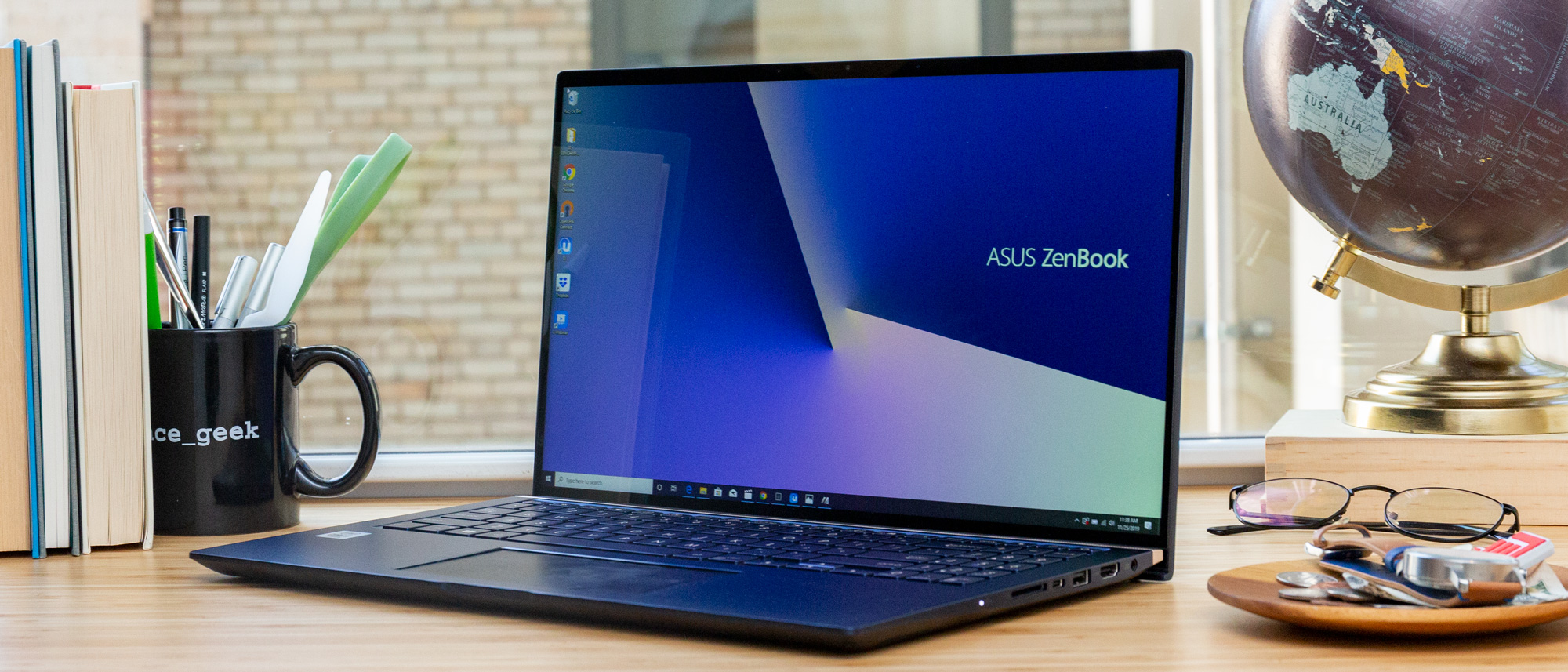Laptop Mag Verdict
The Asus ZenBook 15 (UX534F) combines an Intel Comet Lake processor and improved ScreenPad technology in a slim, beautiful chassis.
Pros
- +
Glamourous, durable design
- +
Improved ScreenPad functionality
- +
Comfortable keyboard
- +
Great audio
Cons
- -
Mixed performance
- -
Display could be brighter
Why you can trust Laptop Mag
Asus sure knows how to make a beautiful laptop. The company also knows how to turn gimmicks into bona fide features. Asus combines both talents on the ZenBook 15 (UX534F). Priced at $1,399, the laptop bucks the silver/rose-gold trend and goes with a bewitching blue chassis that's as durable as it is alluring. The company also brings back ScreenPad in a larger space, with even more functionality. Throw in an Intel Comet Lake processor, discrete graphics and longer battery life, and you've got a great laptop for mobile professionals who don't want to splurge on the 16-inch MacBook Pro
Asus ZenBook 15 design
Like most Zenbooks, the UX534F is a delight for the eyes. The aluminum royal-blue chassis lined by Asus' telltale concentric circle pattern conjures imagery of a beautiful yet restless sea. The Asus logo at the center of the lid gleams as a golden refuge in the raucous waters. The metallic lid is cool to the touch, but it's a fingerprint magnet, which I discovered as soon as I attempted a caress.
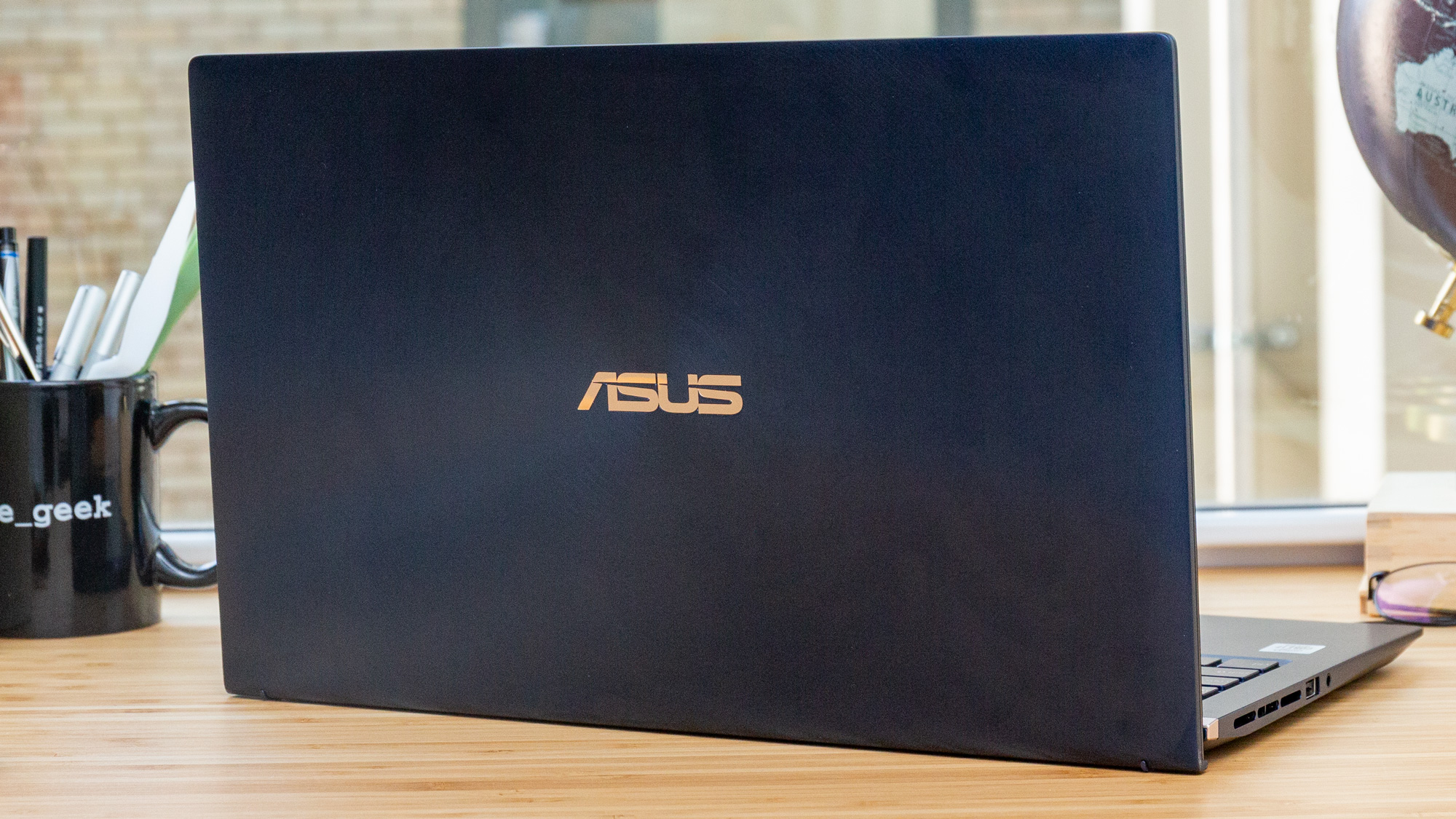
Opening the lid provides even more of that blue-and-gold motif. The entirety of the deck is done in royal-blue aluminum, topped off by a gold vent stamped with Asus ZenBook in the center. The keyboard is also blue with gold lettering. Directly below is an absolutely massive touchpad that doubles as Asus' proprietary ScreenPad 2.0 (more on that later).
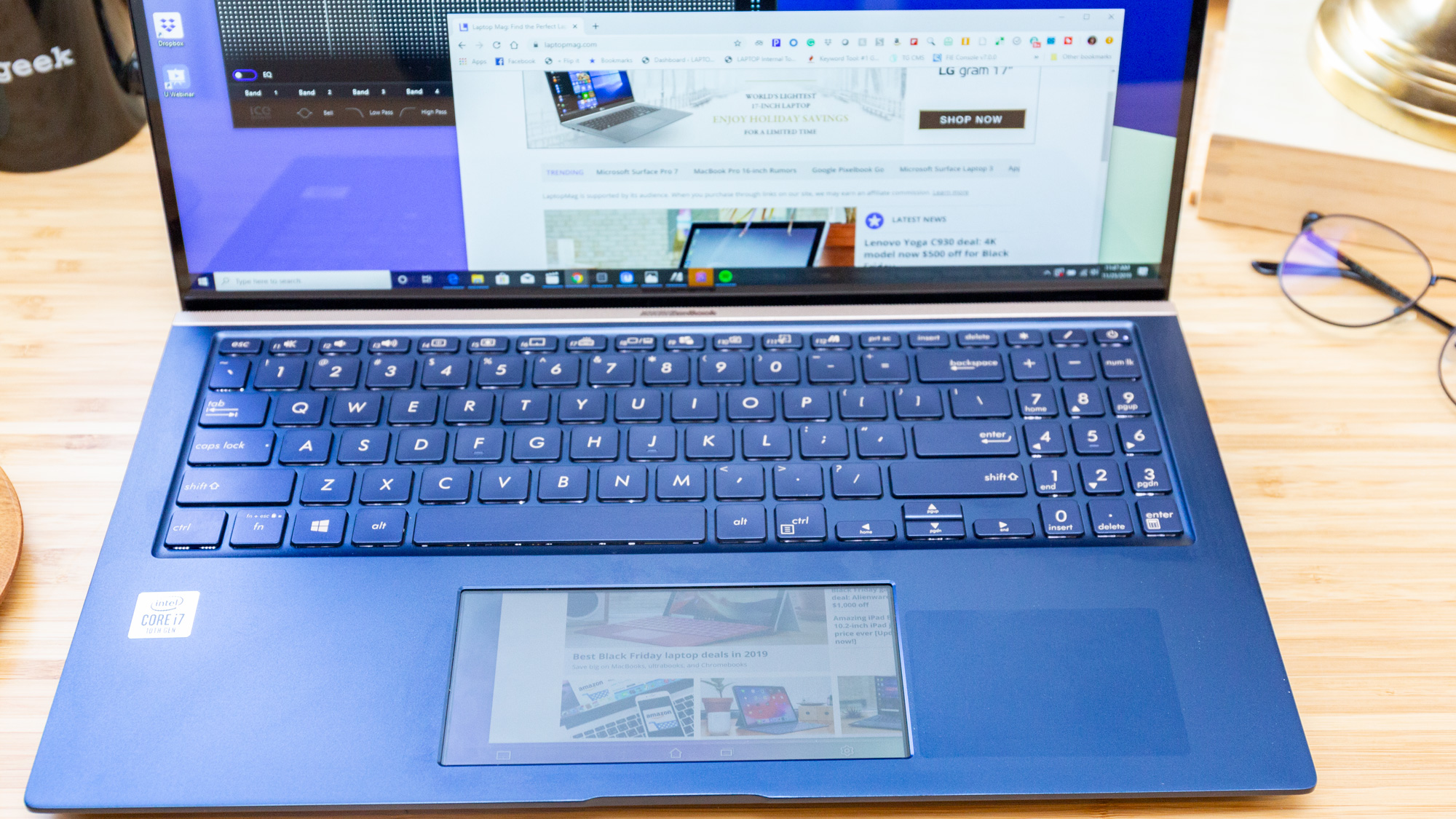
As you open the lid, you deploy Asus' proprietary ErgoLift hinge, which raises the keyboard deck ever so slightly, making for a more comfortable typing experience. The raised deck also allows for better cooling, which leads to better performance. It also puts a little space between the bottom-mounted speakers and a flat surface for better audio.
At 3.7 pounds, the 13.9 x 8.7 x 0.7-inch ZenBook 15 lives up to the hype of being one of the world's most compact 15-inch systems. It's lighter and smaller than the MacBook Pro 16 (4.3 pounds,14.1 x 9.7 x 0.6 inches), Dell XPS 15 (4.5 pounds, 14.1 x 9.3 x 0.5~0.7 inches) and 15-inch HP Spectre x360 (4.6 pounds, 14.2 x 9.8 x 0.8 inches). The 14.4 x 9.2 x 0.6-inch MSI Prestige 15 is slightly lighter at 3.6 pounds.
Asus ZenBook 15 durability and security
Don't let that pretty facade fool you, the ZenBook 15 is one tough notebook. The laptop has endured a barrage of MIL-STD-810G testing, ensuring that it can take a beating and keep ticking. The laptop has passed tests dealing with extreme altitudes, humidity, drop, shock, vibration and temperatures.
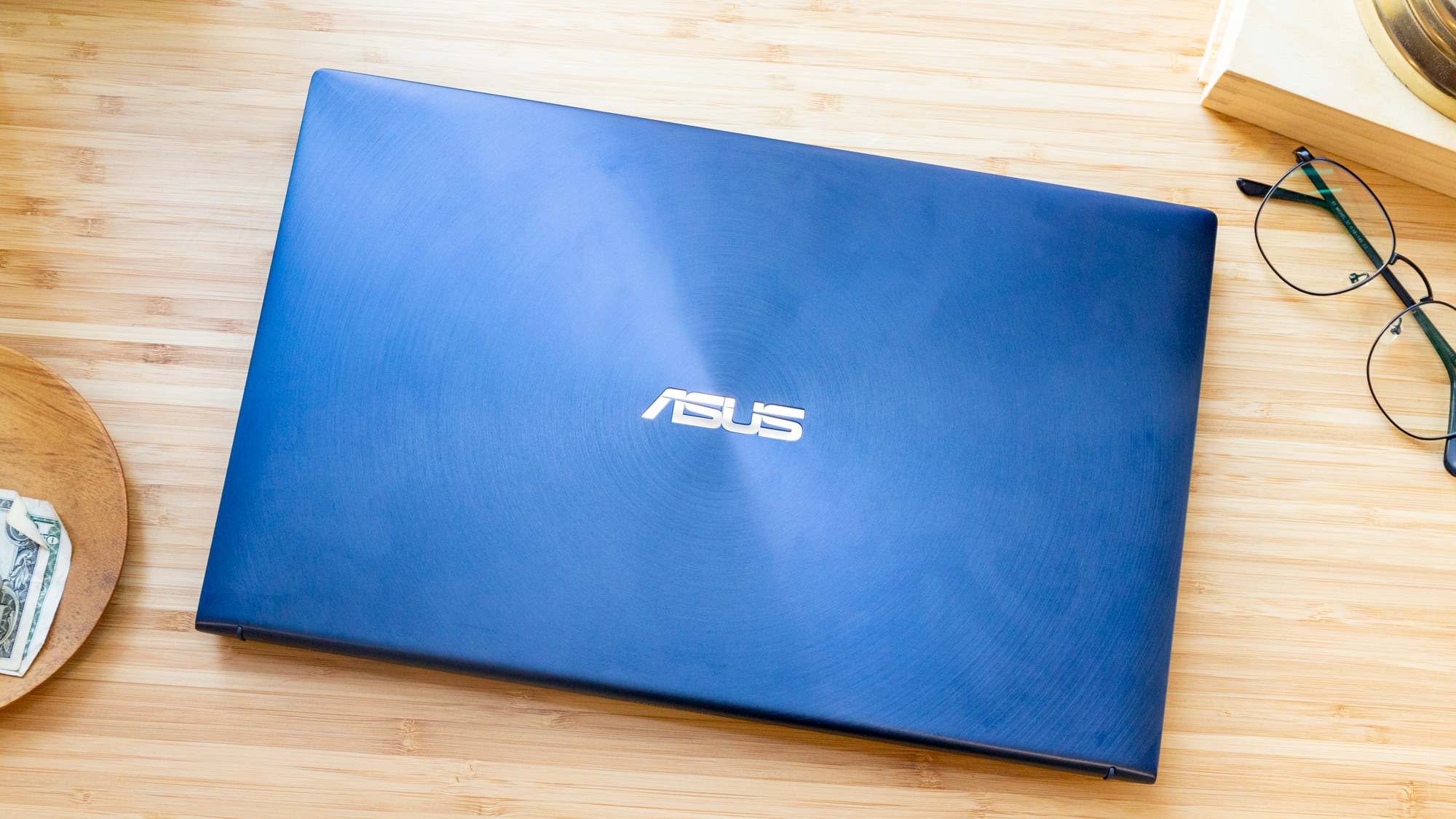
In order to protect your precious data, Asus outfitted the ZenBook 15 with a TPM 2.0 module that allows IT managers to institute secure user authentication and other high-level security measures. The webcam has 3D IR technology, which comes in handy for facial recognition login software like Windows Hello.
Asus ZenBook 15 ports
The ZenBook 15 offers a good amount of ports that can accommodate a variety of displays and peripherals if needed.
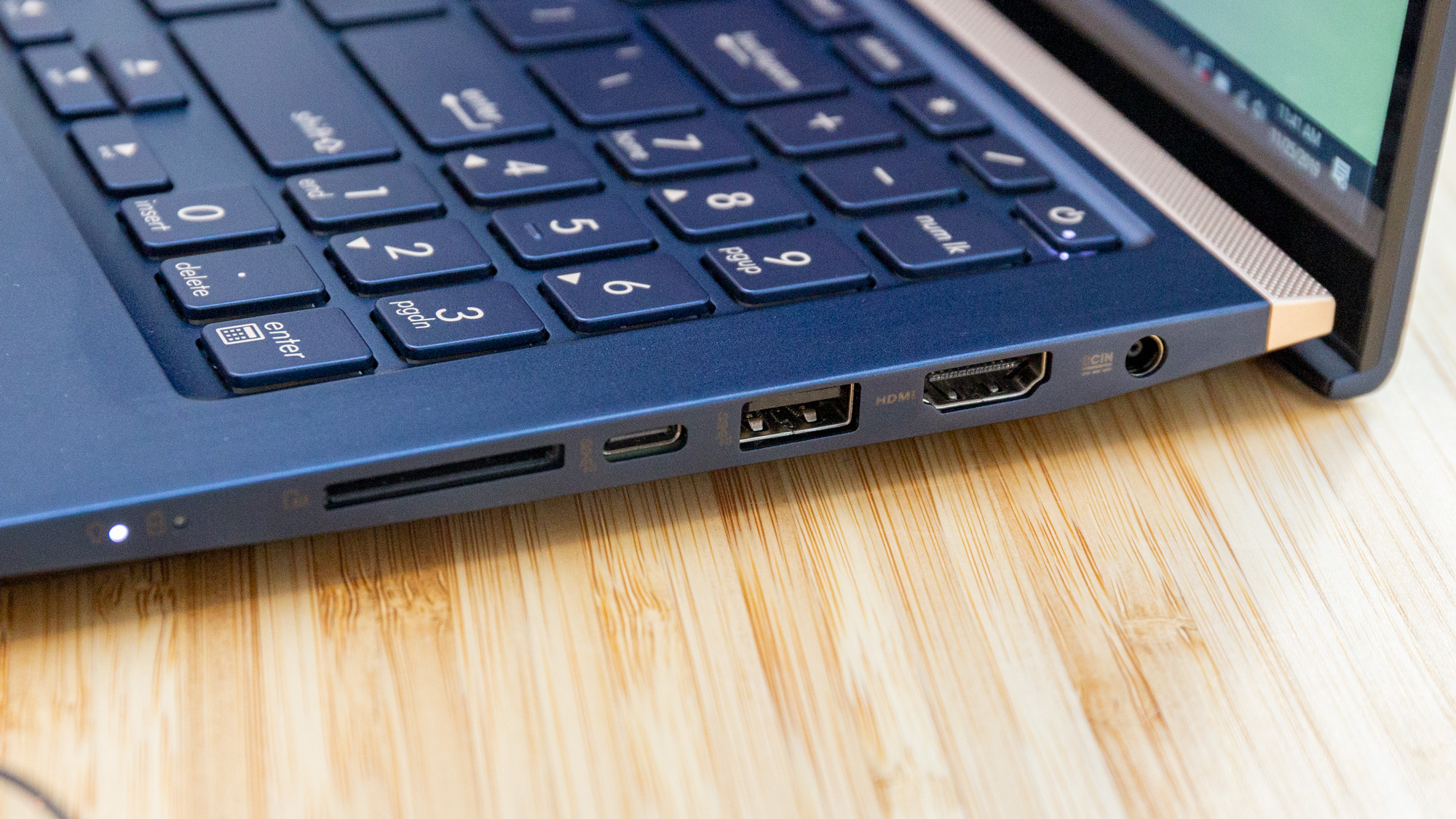
On the right, you have a USB 3.1 Type-A Gen 2 port, a USB 3.1 Type-C Gen 2 port, HDMI, an SD card reader and the power jack.

Along the left, you get another Type-A Gen 2 port and the headset jack.
ScreenPad 2.0
It's baaack! Bigger and better than ever, Asus' ScreenPad technology returns as ScreenPad 2.0, boasting more functionality than its predecessor. Powered by the ScreenXpert software, ScreenPad 2.0 is designed to be an accoutrement to Microsoft Office, with the aim of enhancing productivity. The LCD touchpad boasts a resolution of 2160 x 1080 with a refresh rate of 60 Hz.
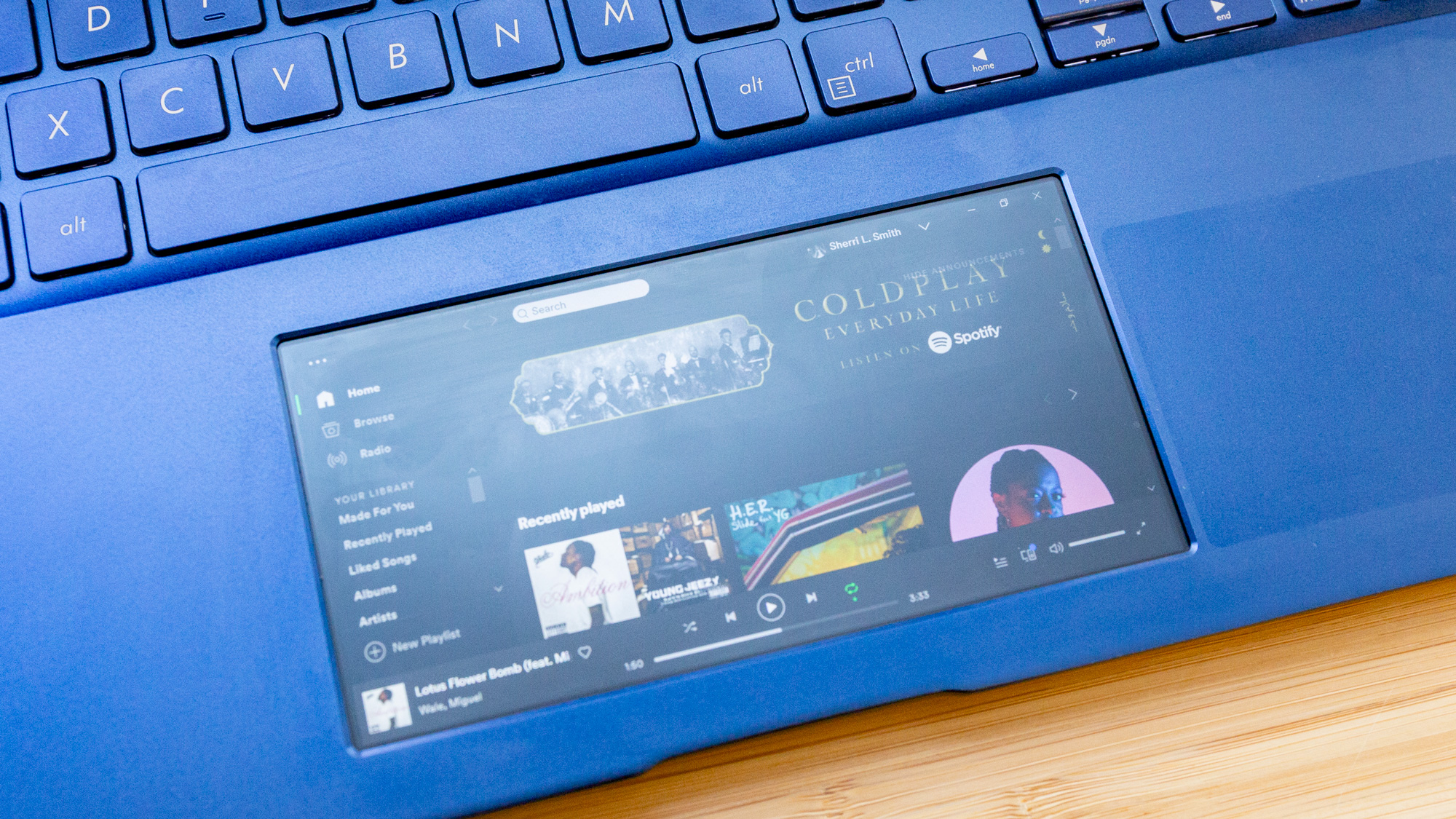
ScreenPad 2.0 resides in the giant touchpad and to enable or disable it, you simply hit F6. When activated, to switch between touchpad and ScreenPad, you need to hit the X button in the top-right corner of the touchpad to access ScreenPad and hit the touchpad icon in the lower left to switch. When activated, ScreenPad 2.0 has nine preloaded apps, including Number Key, which turns the pad into a big digital number pad; Handwriting, in case you need to jot something down; and Spotify, when you need a little work music.
My favorite ScreenPad app continues to be Quick Key, which allows you to create hot keys that can be used in certain apps. For instance, Quick Keys' default hot keys correspond to Windows 10 shortcuts such as cut, paste and copy. Speaking of Microsoft, utilities like Slide, Doc and SheetXpert work in tandem with PowerPoint, Word and Excel. As cool as that is, I rarely use Office 365 anymore, so I'm hoping Asus has something in the works with Google.
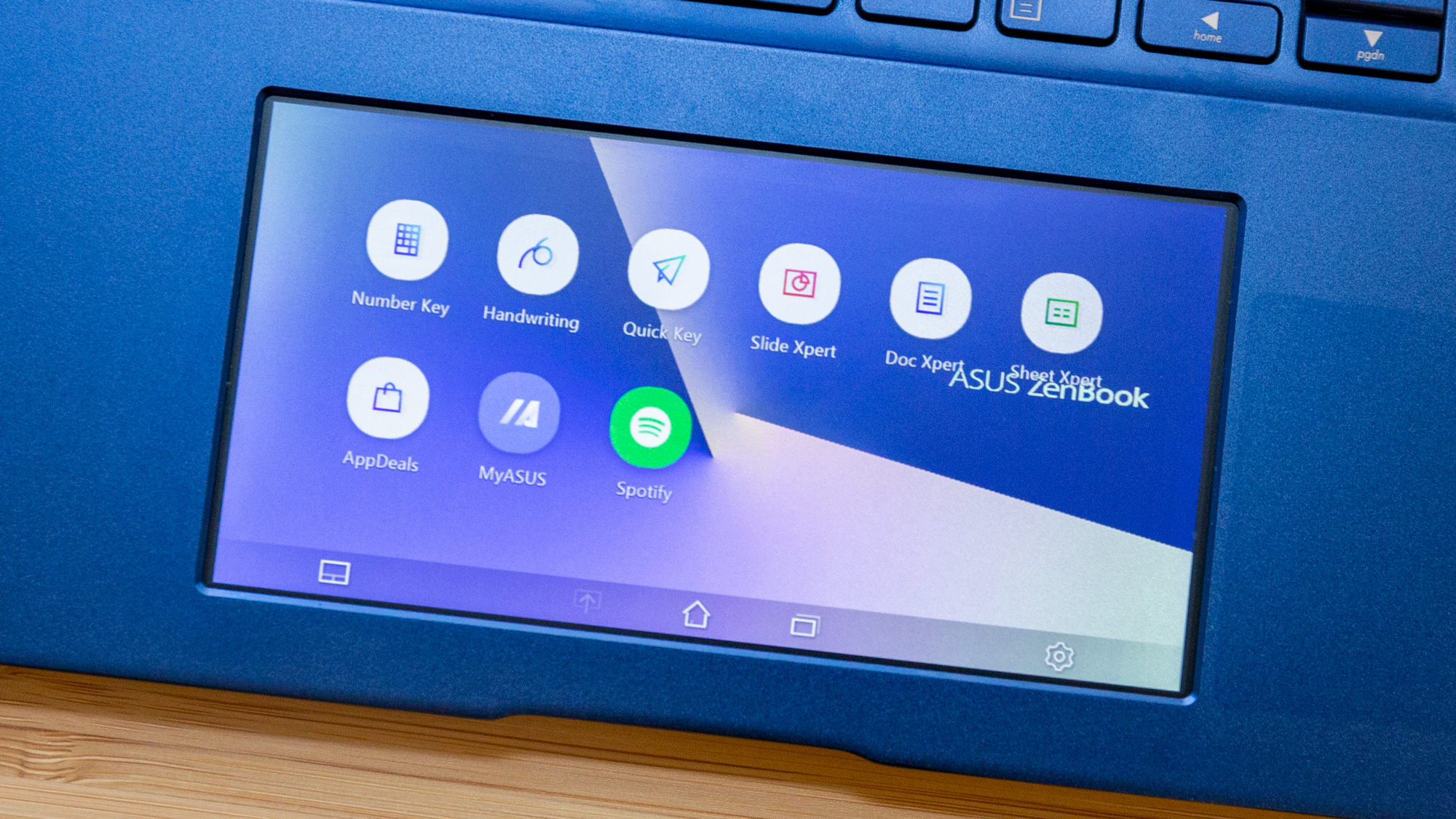
You can also add third-party apps like Spotify to ScreenPad for easy access. These apps can either be used in ScreenPad 2.0, or you can interact with them via the main screen with the App Switcher function. And if you want to quickly access an app in the ScreenPad, you can pin it there by dragging it onto the Add icon.
The best thing about ScreenPad 2.0 isn't some flashy new app. It's the new power efficiency, which puts less of a strain on battery life and puts ScreenPad into battery-saving mode when not in use. For me, that meant the laptop lasted over 8 hours, but I'd like to see how the laptop would fare with a 4K panel.
Asus ZenBook 15 display
Ah, the marvels of engineering and design. Somehow, Asus managed to finesse a 15.6-inch, 1920 x 1080 display into a 14-inch chassis. And to sweeten the pot, the laptop has super-slim bezels. Not as slim as the Dell XPS 15 with its InfinityEdge bezels, but still pretty impressive.

It also helps that the display actually looks good. Watching the 1080p trailer for The Photograph, actress Issa Rae's marigold dress was resplendent against her mocha-brown skin and reddish-brown hair. It gave the effect of living, breathing sunlight. Details were so sharp that I could see the gentle waves in her long, cascading ponytail.
As lovely as the screen appears, I was shocked to see that the ZenBook 15 only reproduced 103% of the sRGB gamut. It's higher than our 100% minimum, but nowhere near the 123% premium laptop average or the 157, 159 and 210% delivered, respectively, by the Spectre x360, Prestige 15 and XPS 15. It was within throwing range of the 16-inch MacBook Pro, which got 114%.
Another area where the ZenBook 15 fell short was its brightness, with the panel averaging 279 nits. It beat the Spectre x360's 247 nits. But it's a far cry from the 358-nit average or the 418, 428 and 429 nits put up, respectively, by the XPS 15, Prestige 15 and MacBook Pro.
Asus ZenBook 15 audio
I have to say, I was really surprised at how good the ZenBook 15's pair of speakers sounded. Buoyed by a smart amplifier and Asus' Audio Wizard software, the Harmon/Kardon speakers bathed my small bedroom with Donell Jones' warm vocals on his cover of "Knocks Me off My Feet." Out of the three presets (Bypass, Music and Movies), Music became my mainstay, since it provided the best overall performance.
That means that although it doesn't have a subwoofer, the low end actually had a bit of weight to it without distorting the mids and highs.
Asus ZenBook 15 keyboard and touchPad
Snappy, well-spaced and above all comfortable, Asus did a great job with the ZenBook 15's keyboard. My fingers never bottomed out, and I never had to worry about inadvertently hitting a wrong key due to the rather large size of the keys. It's also pretty impressive that the company added a number pad without shrinking down any of the main keys to do it and still had room to add arrow keys. My biggest gripe is the backlighting, which I wish shone through the lettering, which would help typing in the dark.
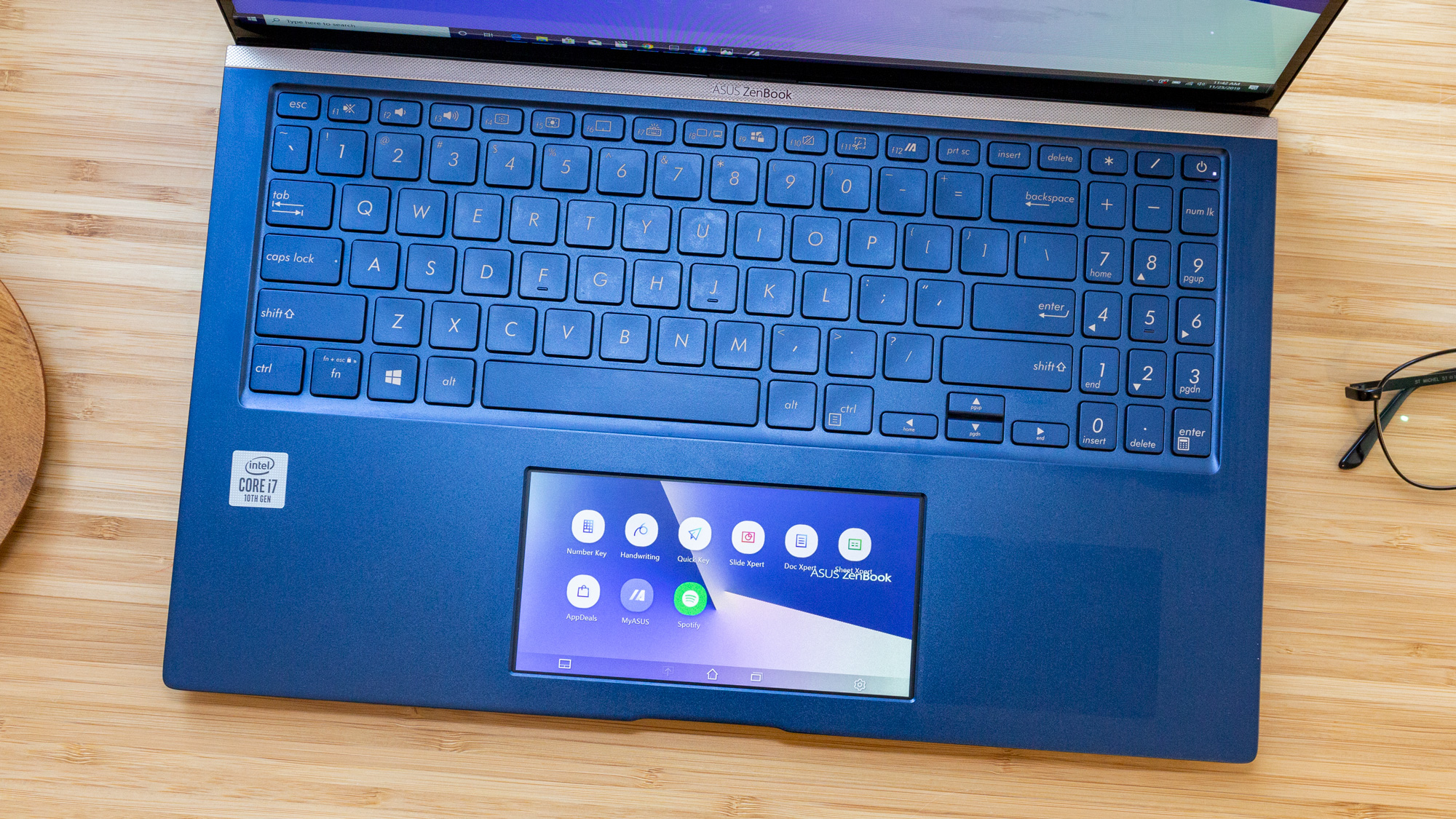
I achieved 75 words per minute on the 10FastFingers typing test, which is better than my normal 70 wpm.
The laptop's 5.1 x 2.6-inch touchpad has more than enough real estate to navigate documents and web pages and perform Windows 10 gestures. Performing pinch-to-zoom, two-finger scroll and three-finger tap was quick and responsive. The bottom corners of the pad delivered springy feedback accompanied by a nice click.
Asus ZenBook 15 performance
Asus is one of the first laptops to give the world its first taste of Intel's 10th Gen Comet Lake processors. The ZenBook 15 has a 1.8-GHz Intel Core i7-10510U processor with 16GB of RAM. A 14-nanometer chip, Comet Lake processors are the next step up from the 8th Gen Whiskey Lake chips. That stated, they're all about big performance, particularly with heavy workloads and multitasking. In fact, Intel claims that Comet Lake chips offer 16% better overall performance than the previous-gen chips.
The laptop held up pretty well during my multitasking test. I launched 30 tabs in Google Chrome, half of which were streaming video from YouTube or Twitch while I worked in a massive spreadsheet in Google Docs. I didn't see any signs of slowing even when I started running formulas.
However, the ZenBook 15 was less impressive during our synthetic benchmarks. When we ran Geekbench 5.0, which measures overall performance, the ZenBook 15 notched 4,410, which beat the 4,367 premium laptop average. However, the Prestige 15 and its Core i7-10710U CPU reached 4,390. The XPS 15 and MacBook Pro with their Core i9-9900HK CPU obtained 7,584 and 7,201, respectively.
The ZenBook 15 took 13 minutes and 17 seconds to transcode a 4K video to 1080p on the Handbreak test. That time was enough to best the Prestige 15's 14:46 and the 21:41 category average. However, the Spectre x360 clocked in with 10:45, while the XPS 15 and MacBook Pro sped past at 8:00.
During the File Transfer test, the ZenBook 15's 1TB PCIe NVMe SSD took 6 seconds to duplicate 4.97GB of multimedia files. That's a transfer rate of 771.1 megabytes per second, which was enough to breeze past most of the competition, including the 538.8-MBps average, with the exception of the MacBook Pro, whose 2TB M.2 PCIe NVMe SSD delivered a whopping 1,017.9 MBps.
Asus ZenBook 15 graphics
You're not going to play Red Dead Redemption 2 (at least not well) with the ZenBook Pro's Nvidia GeForce GTX 1650 Max-Q GPU with 4GB of VRAM, but you can expect to play some AAA titles. But the discrete graphics card is really there to help with the heavy lifting when it comes to mid-level content creation and multitasking.
Still, the notebook did score 153 frames per second on the Dirt 3 benchmark, easily defeating the 60-fps category average. Outfitted with their own 1650 Max-Q GPUs, the Spectre x360 and Prestige 15 achieved 61 and 181 fps, respectively, while the XPS and its full 1650 produced 80 fps.
For those times when you're just working in a spreadsheet or watching a video, the ZenBook 15 switches over to its integrated Intel UHD Graphics GPU.
Asus ZenBook 15 battery life
Two screens are better than one, except when it comes to battery life. The ZenBook 15 lasted 8 hours and 34 minutes on the Laptop Mag battery test (continuous web surfing over Wi-Fi at 150 nits of screen brightness) with ScreenPad 2.0 turned off. That's definitely better than last year's ZenBook Pro 15, which lasted a mere 5:14. However, it should be noted that my iteration of the ZenBook 15 only has a 1080p panel, compared with the Pro's 4K display.
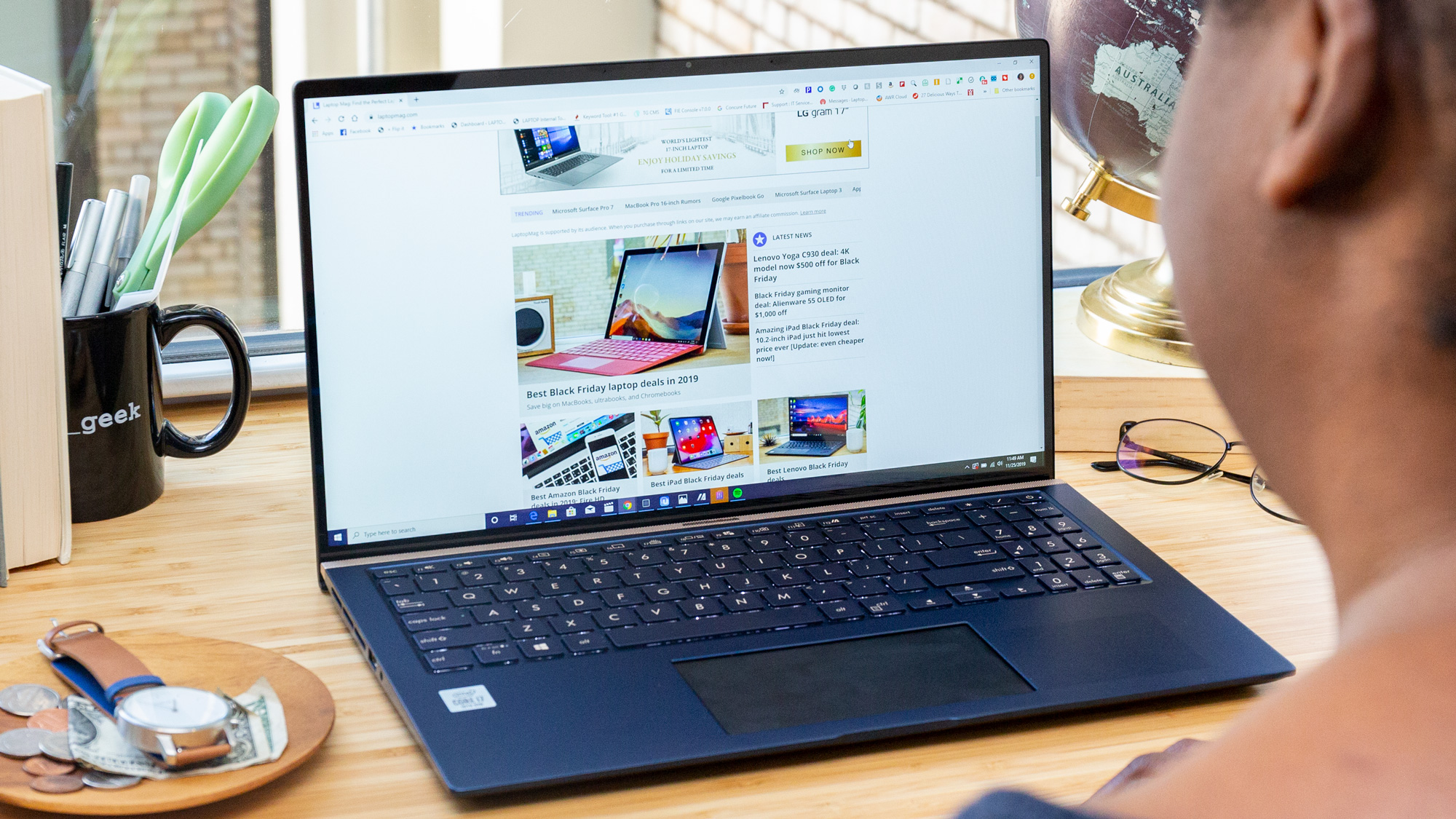
And while the ZenBook's time beat the Prestige 15 (7:55) and Spectre x360 (8:09), it was a few minutes short of the 8:37 premium laptop average and nowhere near the 16-inch MacBook Pro's 10:55.
Asus ZenBook 15 heat
For all intents and purposes, the ZenBook should be a crotch incinerator, with its two screens and relatively high-powered specs. Yet after 15 minutes of playing a full-screen YouTube video, the touchpad measured only 84 degrees Fahrenheit. That's well below our 95-degree comfort threshold. The center of the laptop reached 88 degrees, while the undercarriage rose to 90 degrees.
Asus ZenBook 15 webcam
The ZenBook 15's webcam does a great job of capturing accurate color — but with detail, not so much. However, it's not the worst webcam I've seen. It managed to capture my light-pink shirt and the rich browns of my wooden headboard.
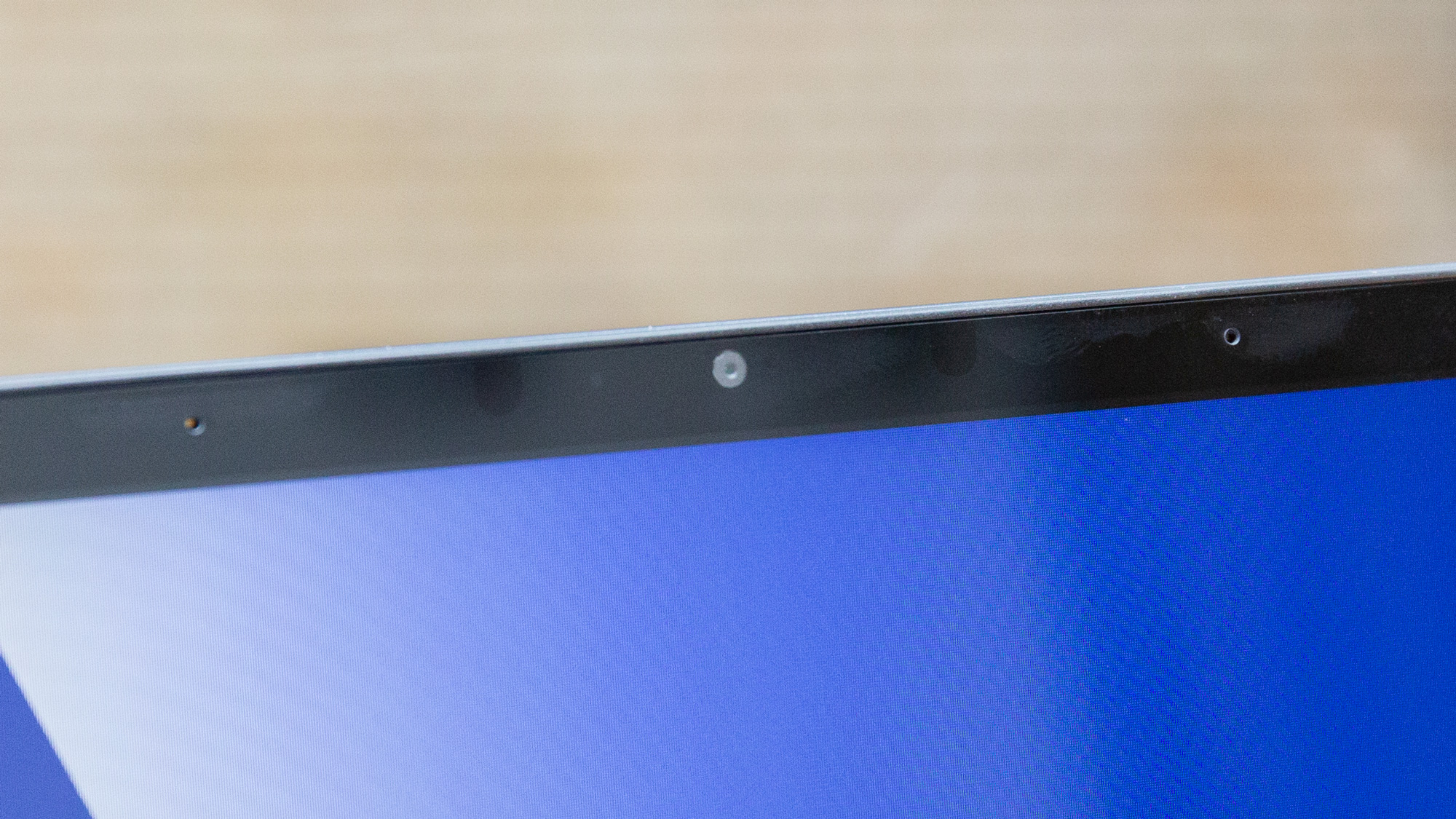
The details were muddy, but I was impressed by the shooter captured a little of the patterns in the natural grain of the wood. But if you're planning to do a lot of video capture, I'd recommend getting an external webcam.
ZenBook 15 software and warranty
Asus preinstalled a rather modest suite of apps on the ZenBook 15. MyAsus is the most useful of the Asus-branded software, as it allows you to run system diagnostics, contact tech support and even change the color temperature of the display.
Third-party apps include Evernote, Spotify, McAfee Personal Security, Netflix and Nvidia GeForce Experience and Control Panel. The usual Windows 10 bloatware also makes an appearance, including Candy Crush Friends and Microsoft Solitaire Collection.
The Asus ZenBook 15 ships with a one-year limited warranty. See how the company fared on our annual reports, including Tech Support Showdown and Best and Worst Laptop Brands.
ZenBook 15 bottom line
The Asus ZenBook 15 isn't a story of reinvention. It's a story of making little tweaks here and there and putting a high polish on what was already a great laptop. The ZenBook 15 maintains the glamourous looks of its predecessor and adds MIL-SPEC durability to the mix. It keeps the surprisingly useful ScreenPad, makes it bigger and adds more useful apps. The keyboard now sports a number pad and the bezels are noticeably smaller. Heck, the battery life is now nearly twice as long.
The biggest addition to the ZenBook is Intel's Comet Lake, which is powerful enough for multitasking, but this chip is no match for the Core i9 processors found inside the Dell XPS 15 and 16-inch MacBook Pro. Those laptops from Dell and Apple also benefit from brighter displays, while the pricier MacBook Pro lasts a lot longer on a charge.
For $1,399, the ZenBook 15 has a lot of wins going for it, though, particularly ScreenPad 2.0, which the company is determined to prove is more than just a gimmick. And honestly, the more I use it, the more inclined I am to believe Asus. Overall, the ZenBook Pro is a great choice for mobile professionals who want to squeeze every bit of functionality possible out of their notebook.
Asus ZenBook 15 (UX543F) Specs
| Size | 13.9 x 8.7 x 0.7 inches |
| Display | 15 inches (1920 x 1080 pixels) |
| CPU | 1.8-GHz Intel Core i7-10510U processor |
| GPU | Nvidia GeForce GTX 1650 Max-Q/Intel uHD Graphics |
| Weight | 3.7 pounds |
| Storage | 1TB |
| RAM | 16GB |

Sherri L. Smith has been cranking out product reviews for Laptopmag.com since 2011. In that time, she's reviewed more than her share of laptops, tablets, smartphones and everything in between. The resident gamer and audio junkie, Sherri was previously a managing editor for Black Web 2.0 and contributed to BET.Com and Popgadget.
